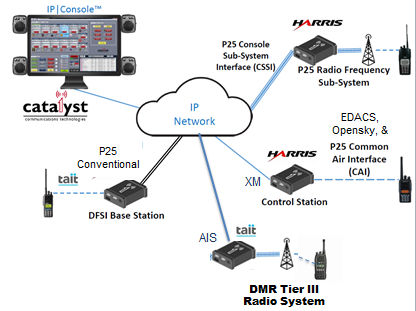Earlier this month, Harris and Tait Communications announced an exclusive agreement between the two companies, including integrating the two vendors’ distribution channels.
Under the agreement, Harris becomes the master exclusive distributor for all of Tait’s  products, including Digital Mobile Radio (DMR) and Project 25 (P25), in North America. The announcement comes at the end of Harris’ DMR agreement with Hytera, whereby Harris was reselling DMR equipment from Hytera under the Harris name.
products, including Digital Mobile Radio (DMR) and Project 25 (P25), in North America. The announcement comes at the end of Harris’ DMR agreement with Hytera, whereby Harris was reselling DMR equipment from Hytera under the Harris name.
Harris and Tait are in the middle of their integration rollout plan, and it will be interesting to learn how the two companies products are positioned vis-a-vis each other, especially in mixed networks. This is where Catalyst can provide a major role for customers looking to take advantage of the new partnership.
One strong application for Catalyst is with current EDACS customers wishing to migrate to TAIT DMR. Since Catalyst has intelligent user interfaces to both Harris and Tait radios, including AIS, DFSI, CSSI, & Control Station Interfaces, these radios can exist on a single IP network managed with Catalyst Consoles. And,  Catalyst Interoperability solutions provide a migration path for customers who wish to move from EDACS to DMR, EDACS to P25 Conventional, Etc. with or without Catalyst Consoles.
Catalyst Interoperability solutions provide a migration path for customers who wish to move from EDACS to DMR, EDACS to P25 Conventional, Etc. with or without Catalyst Consoles.
Another strong use case for Catalyst solutions is with Tait Conventional P25 radios. Catalyst Consoles and Interoperability solutions control Tait DMR Trunking Systems and Tait P25 conventional base stations today. The same cannot be said of the current line of Harris Consoles, including Symphony(r).
The industry should be pleased with the partnership, as consolidation can often simplify service and solution choices. Knowing that strong third party solutions that complement these partnerships exist and enhance application capabilities is especially helpful to customers.

